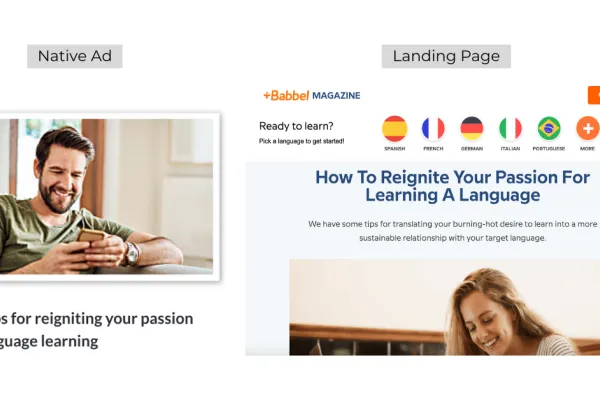
 Details
Details
What if I told you that the secret to native advertising success can be found by digging deep into the past?
How deep? Well, around the mid-20th century – so not ancient history but probably before most of today’s native advertising pros were born. And don’t worry, I promise this isn't one of those boring history lessons.
Back in the 1960s, much of the advertising people encountered was either in print, radio or television. A particular type of print advertising was being used effectively to generate sales from both the mass market and niches. It was called direct mail. However, despite the knowledge and keyed advertising insights available at the time, it was a tough business and many failed miserably, some without even knowing why.
The art collector who took the mystery out of direct response marketing
One of the most accomplished advertisers at the time was Eugene Schwartz, a renowned copywriter also known as a direct mail specialist. Many say his secret to success was studying the products he promoted religiously, often uncovering ideas that most would miss.
He was not only an avid art collector and advertiser but also an author. In 1966, Schwartz's book Breakthrough Advertising (now a rare collectible) was first published. It went on to become something like a bible for advertisers and direct response marketers all over the world.
But these days, his teachings seem to have been lost to time thanks to the advent of the internet, technology and automation.
Some advertisers, however, are making native ads work with Eugene's "breakthrough concept".
Meeting people where they are
If you've never heard of this legendary advertiser, you've probably already opened another tab to Google him. But no need. I’m going to introduce you to Schwartz’s concept of customer awareness, which was so revolutionary at the time that it left other advertisers either baffled or sceptical.
Even if you have no idea who Schwartz is, you might find yourself familiar with his basic thesis on the five stages of audience awareness. You've almost certainly come across the phrase "meet people where they are" - but what does that mean exactly and how does it tie into a nearly 60-year-old book?
According to Schwartz, there are five stages of awareness in any given market at any point:
- Unaware: people who are happy as can be, not aware they have a problem
- Problem Aware: folks who are aware of a particular problem that troubles them
- Solution Aware: those who know that there's a solution (or several) to their problem
- Product Aware: people who already know your product as a possible solution
- Most Aware: your existing customers, leads or contacts
Here's a more practical and visual perspective to get you thinking about how to apply the concept to native advertising.

The further to the left you go, the bigger your pool of potential customers but the more difficult it is to convert them. The user journey of those in the “Unaware” category is quite long because people need to be educated before they're ready to buy from you, at which point they're Product Aware.
On the other hand, the further to the right you go, the easier it is to convert traffic because people either already know what they want or who to buy it from. There's more knowledge and urgency to act in the prospect's mind.
Many marketers spend a lot of time focusing on Stages 4 and 5. That’s why search ads are so popular. However, the biggest opportunity lies at Stages 1 and 2 - where only the best marketers dare to play.
So, what changes with the different awareness stages? Mainly your copy angles, headlines and content. Let's take a deeper look, in the context of native advertising.
Native ads success in the old book
In Schwartz’s book, the concept of customer awareness stages has a broad spectrum. But it can and should be applied to native ads. Truthfully, it should be applied to any advertising, marketing campaign or piece of content.
A Product Aware native ad headline, for example, will most likely fail when shown to a Problem Aware audience. It's sort of the "your place or mine at first sight" approach that seems to be in many marketers' bag of tricks. But often this incongruence is what causes ads and subsequently content to underperform.
To achieve native ad success, the journey from ad to content needs to align with one awareness stage. Once people consume the content they typically move to the next stage of awareness.
Here's an excellent example from Babbel, the well-known language-learning app.

- What's the problem? Lack of drive to learn a new language.
- What's the solution? The article explains.
- What's the next step? Try Babbel.
- What next? Subscribe to Babbel.
The user moved from Problem Aware to Solution Aware to Product Aware to Most Aware. Easier said than done.
From a hands-on perspective, what does all of this mean in terms of campaign setup?
Ideally, you want to split native campaigns by awareness stage and create content and ads for each. That way, your campaigns are a lot more focused, which helps to drive better performance.
Isn't that going to be more work in addition to splitting by device and geography as mentioned in these native best practices? Of course it is. But good campaigns are rarely easy.
Cracking your prospect's mind
"How aware is my audience?" This is a fundamental question that many marketers miss, either by laziness or lack of knowledge.
The answer to this question can make things much clearer when planning native campaigns. Plus, it takes the guesswork out of the equation.
It tells you what content to create, what to say in the headline, what copy angles to use in your ads and how to structure your campaigns. Above all, it gives you confidence.
Identifying your market awareness stages (you're often targeting more than one) is part of the audience research process, which can be time-consuming and boring. It's not my favourite part and probably not yours either. But it is crucial to native success. Armed with knowledge and insights about the people you're looking to reach, you'll be better prepared to tackle the challenges of native advertising.
Schwartz understood that in 1966 and the same principles apply today.

